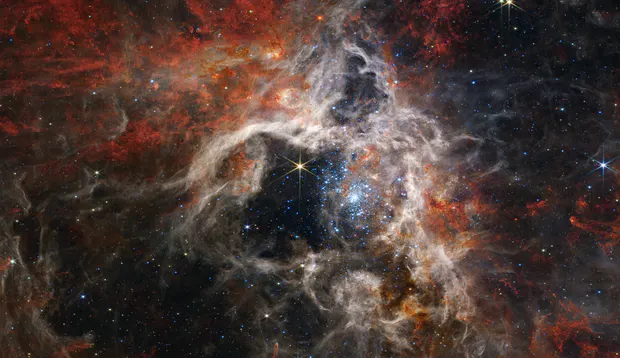NASA's Webb Telescope Captures Thousands Of Young Stars In Tarantula Nebula
NASA's highly sensitive James Webb Space Telescope has captured an extremely detailed image of thousands of never-before-seen young stars in a region known as the Tarantula Nebula.Wednesday, September 7th 2022, 8:02 am
NASA's highly sensitive James Webb Space Telescope has captured an extremely detailed image of thousands of never-before-seen young stars in a region known as the Tarantula Nebula.
Located in the Large Magellanic Cloud, which is around 160,000 light years from Earth, the nebula, also known as stellar nursery 30 Doradus, is a region of very active star formation, according to NASA's Jet Propulsion Laboratory.
Related Story: Webb Telescope Captures Its 1st Direct Image Of An Exoplanet
NASA's mosaic image of the nebula covers an area of 340 light-years. Viewed with Webb's Near-Infrared Camera (NIRCam), the region resembles a burrowing tarantula's home. But it was actually named the Tarantula Nebula for its dusty filaments captured in previous telescope images.
 Image Provided By: CBS News
Image Provided By: CBS News
The nebula is home to the hottest, most massive stars known to exist. And it's of major interest to astronomers because, unlike in our Milky Way, it is producing new stars at a "furious rate."
Studying the nebula also offers astronomers a unique insight into our universe's past and how stars formed in the deep cosmic past. Though close to us, the chemical make-up of the nebula is similar to the gigantic, star-forming regions from when the universe was only a few billion years old, and star formation was at its peak — a period known as "cosmic noon."
The sparkling blue stars seen in the image are responsible for creating the nebula's cavity — located right at the center of the NIRCam image — with their own radiation.
"Only the densest surrounding areas of the nebula resist erosion by these stars' powerful stellar winds, forming pillars that appear to point back toward the cluster," said NASA. These pillars contain young stars called "protostars," which form in cocoons of dust.
Webb's NIRCam caught one very young star still gathering mass in a cloud of dust and gas.
"Astronomers previously thought this star might be a bit older and already in the process of clearing out a bubble around itself," NASA said. "However, NIRSpec showed that the star was only just beginning to emerge from its pillar and still maintained an insulating cloud of dust around itself. Without Webb's high-resolution spectra at infrared wavelengths, this episode of star formation in action could not have been revealed."
NASA also used its Mid-Infrared Instrument (MIRI), which is capable of penetrating deeper into the cosmos than a telescope using visible light, to look at the nebula. The MIRI revealed a very different side of the celestial structure and a "previously unseen cosmic environment," NASA said.
"The hot stars fade, and the cooler gas and dust glow," NASA said. "Within the stellar nursery clouds, points of light indicate embedded protostars, still gaining mass."
Webb, a joint project from NASA, the European Space Agency and the Canadian Space Agency, launched on Christmas Day last year, after more than 20 years of development, and by July it has begun delivering stunning new images of the cosmos.
"Webb has already begun revealing a universe never seen before, and is only getting started on rewriting the stellar creation story," NASA said.
Correction: This story has been updated to note that Webb launched on Christmas Day but took several more months to begin sending images.
More Like This
September 7th, 2022
June 10th, 2024
December 17th, 2023
August 10th, 2023
Top Headlines
December 13th, 2024
December 13th, 2024
December 13th, 2024
December 13th, 2024









